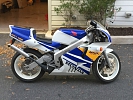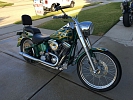1990 BMW K1
1990 BMW K-Series
| Price: | US $12,500.00 |
| Item location: | Trivoli, Illinois, United States |
| Make: | BMW |
| Model: | K-Series |
| SubModel: | K1 |
| Type: | Sport Bike |
| Year: | 1990 |
| Mileage: | 20,041 |
| VIN: | WB1053505L6365378 |
| Color: | Blue / Yellow |
| Engine size: | 1,000 |
| Vehicle Title: | Clear |
| Contact seller: | Contact form |
This bike is one of my favorites in my collection. There were only 6,xxx of these bikes ever made. There were only 1174 of these bikes made in this color scheme, nd of that 1174 only 613 were imported to the United States. Do a search on ebay, nd other sites and try and locate these bikes for sale. It is hard to find them in this color scheme. The more common solid color versions are out there but were made 1991 and later. This is the original Blue and Yellow, hat was produced in 1991. It is not the common Ketchup and Mustard version that led the color schemes off the assembly line beginning in 1989.
I purchased the bike from an avid BMW collector in Boise. I had the bike delivered directly to the dealership and had them go from front to rear of the bike and fix/replace anything that was in need of repair. I told them to not even attempt to start the bike as it sat for almost 2yrs.. told them to replace fuel pumps/filters/fluids/battery, nd do a complete service on the bike, nd tires are 85% new. This bike at 25yrs old runs good as new, nd handles as new. The only thing this bike needs is a new home.
Included with the bike:
- Tool kit and tire repair kit. (original)
-3M Protection around rear box lids to prevent scratching (applied on date of original purchase)
- Cee Baileys Headlight protector (applied on date of original purchase)
Australian made Staintune Stainless Steel Performance Exhaust. ($1,200.00 to purchase now, nd Staintune does not carry this part number any longer, efused offer of $900.00 and exchange for OEM exhaust at last bike rally)
Wonderful Bonus to this bike is the ORIGINAL Tank Bag with both original Rain Covers. Additionally, he original saddle bags and original K1 Rain covers. (these items alone are rare and would sell for almost $1,000.00 on the site)
The bike is listed locally for sale and I reserve the right to end the auction at any time. I ride several different bikes throughout the week, ust depends on the mood and route I want to take, o until the reserve is met, will continue have the bike in my rotation)
All of my bikes are taken care of professionally. I assure you that you will not regret this purchase and you will be the envy of all in your BMW chapter when you go to the meetings and rallys. If you do not like to talk to people about your bike or have people approach you about your bike.. DO NOT BUY THIS!!
Below is the history and info from Wiki if you care to learn about the machine you have the opportunity on.
The BMW K1 is a motorcycle that was designed by BMW as a high-speed sports-tourer, esigned to change the motorcycle media and buying public's mind of BMW as only a manufacturer of flat-twin tourers.
Based on the previously introduced BMW K100, he K1 was designed for comfortable high-speed autobahn cruising at speeds of up to 150mph (240km/h). The radical aerodynamic design was a seven piece glass fibre structure, reating a class leading drag coefficient of 0.38. It was mated with a stiffened chassis, hat included a single sided Paralever swingarm, esigned to stop shaft drive induced pitch and dive under heavy acceleration and braking,[1] the first use of this on a K-series bike.
Although expensive and either loved or hated, nd with some of its early technology either working in use or not�the enclosure created excess heat buildup, hile the long wheelbase created a 22ft (6.7m) turning circle�the short production run created the result that the motorcycling press and public never had the same view of BMW motorcycles again.Through the need to meet proposed European Union legislation on emissions regulation, MW had started to develop an alternate technology to its traditional flat-twin engines with the introduction of the 1,000cc BMW K100 from 1983 to 1992. Led by Josef Fritzenwenger and Stefan Pachernegg, he team developed a design based on a liquid-cooled Peugeot car engine. In the base design of the K100, he engine was laid on its side in line with the motorcycle frame, nown as a longitudinal four, with the crankshaft on the right hand side of the motorcycle, ith the cylinders, istons, amshafts, njectors and spark plugs on the left hand side. This arrangement keeps the centre of gravity relatively low, which benefits handling.
Design
The K100 was still a cruiser/tourer design in bias, nd BMW marketing wanted a sports oriented tourer to appeal to a more youth oriented market perception, nd compete with the Japanese factories. BMW was committed to the manufacturer imposed 100bhp (75kW) limit for motorcycles sold in Germany, o decided that to address both issues it needed to turn to aerodynamics to solve the problem.[1]
In 1984 at the Cologne Motor Show, MW design created the aerodynamic "Racer" mockup, ased on a standard K100 chassis.[2] At the 1988 Cologne show, he production K1 used the same large and all enveloping two-piece front mud guard mated closely to a seven-piece main fairing, hat included two small panniers (lids made by Zanussi ZCP (Zanussi Componenti Plastica)). The resultant drag coefficient was 0.34 with the rider prone, he lowest of any production motorcycle in 1988.[1]
Adding to the "different to traditional BMW" nature of the bike, he colour scheme of bright red or blue with yellow graphics and highlighting was bold, nd hence seen as so different to normal BMW, bizarre.[1]
EngineeringThe K1 differed from the K100 in engineering terms, eing designed for high speed and hence with many components either replaced or upgraded.
Retaining the K100�s bore and stroke of 67mm ?70mm (2.6in ?2.8in), he K1 was BMW's first 16-valve engine,[3] using four valves per cylinder, ith the camshafts acting directly on the bucket tappets. Other improvements over the K100 included higher compression pistons, ighter conrods and a 1.3kg (2.9lb) lighter crankshaft.[3] This combined with digital Motronic engine management system resulted in a 10hp (7.5kW) gain over the K100, roducing 100hp (75kW) at the crankshaft at 8,000rpm;[1] and increased torque of 74lb�ft (100N�m) versus the K100�s 64lb�ft (87N�m).
The stronger tubular steel chassis was mounted on wide 17-inch (430mm) FPS front wheels, 8s in the back, ith low profile radial tyres. The rear suspension was a Bilstein shock absorber acting on a single-sided Paralever swingarm, hich pushed the wheelbase out to 1,565mm (61.6in). On the front were twin 41.7mm (1.64in) Marzocchi forks.[4] The brakes were four-pot Brembo over two-pot on the K100, ith a pair of 305mm (12.0in) drilled discs.[4] An Anti-lock braking system was optional in all markets except North America, here it was standard.[1]
Marketing, ales and usageBy the time the K1 was launched, t was quick but not fast. The result of the addition of the aerodynamic bodywork and general upgrading of engineering and components added to the weight, hich as a result came in as heavy for a sports bike at 234kg (516lb). Combined with the extended wheelbase which created a 22-foot (6.7m) turning circle, t made the bike an economical and comfortable sports tourer. But the engine was not powerful enough against the weight to make the bike quick accelerating, nd hence sports-competitive.[1]
The all over fairing was found in early press road tests to retain excess heat below 50mph (80km/h), nd in some cases burn riders. BMW eventually offered an under-fairing heat blanket which reduced this considerably, ut it was always a problem.[5] However, s BMW knew weight was a problem, he panels were well engineered but thin and subject to cracking. Resultantly panel fit was poor on early models, nd combined with panel cracking earned the bike the nickname "yoghurt carton" in Germany. The design and manufacture of the panels never changed in the bikes production, ut the colouring schemes were toned down from a ketchup red and metallic blue with yellow details, o a metallic black.
The engine, lthough well developed, uffered from secondary vibration. This was minimal in the three-cylinder K100 derived K75, and minimised in the K100 through introduction of well designed vibration suppression. On the sporting inspired K1, he engine was directly mounted onto the frame, hich led to secondary vibrations problems at certain mid-range engine revolutions.[5]
In the important United States market, missions regulations dragged the power out down to 95 horsepower (71kW). At almost US$13,000 it was also expensive, nd when compared to the competition the excess price did not offer a sufficient performance or quality gap for volume sales.[5] In comparison, he Honda CBR600F was as fast and lighter, et was almost two thirds of the price.[5]
By 1993, he market had changed and developed considerably, ith the introduction of sports bikes like the Tadao Baba designed Honda Fireblade, brought about the end of production. However, lthough it only sold 6,921 units, he K1 helped BMW change its persona forever with the press and market perception as simply a touring motorcycle manufacturer. It remains one of their most memorable machinesAlso published at eBay.com


